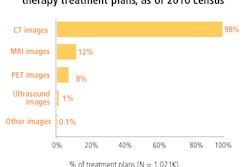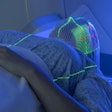Women with invasive breast cancer and lymphatic involvement who received radiation therapy (RT) along with chemotherapy after a modified radical mastectomy had lower recurrence rates than patients who only received chemotherapy, according to research presented at the San Antonio Breast Cancer Symposium.
In a group of 55 Egyptian women, 13% fewer patients who received radiation therapy had no locoregional recurrences five years later, compared to a group of 58 similar patients whose treatment was limited to chemotherapy following a mastectomy. The group that received radiation therapy also had lower rates of distant metastases, according to lead author Niveen Abo-Touk, MD, a radiation oncologist in the department of clinical oncology and nuclear medicine at Mansoura University in Mansoura, Egypt.
Specifically, the percentage of patients in the RT/chemotherapy group who developed distant metastases was 22.4%, compared with 40% in the other group five years following treatment. And only 5.2% of the RT/chemotherapy group developed locoregional recurrences, compared with 18.2% of the chemotherapy-only group.
The women were diagnosed and treated between 1995 and 1998 at Mansoura University Hospital and Tanta University Hospital in Tanta, Egypt. All had up to three pathologically confirmed positive axillary lymph nodes.
Oncology teams made the decision as to whether a patient should undergo radiation therapy. Those women for whom it was recommended received the treatments between the third and fourth chemotherapy cycles. A radiation dose of 50 Gy was administered in five fractions per week for five weeks.
Each group of women had a similar age range (34-73 for the chemotherapy-only group; 33-70 for the RT/chemotherapy group), with a median age range of 50 to 51 years. Slightly more women were premenopausal in the group receiving only chemotherapy (62% versus 57%). The chemotherapy-only group had slightly fewer T2-sized tumors (47.3% versus 51.7%), and only 45.5% had a T3 tumor grade, compared with 53.4% of the RT/chemotherapy group. The number of lymph nodes dissected for each group was comparable and not statistically significant.
Independent factors increasing the risk of cancer recurrence and spread for the total group were, in descending order, the number of involved lymph nodes, tumor size, and tumor grade, Abo-Touk said.
While treatments for mastectomy patients diagnosed with positive involvement of several lymph nodes have changed significantly over the past decade, this retrospective evaluation of 113 patients confirms that postoperative RT following a mastectomy can significantly decrease the risk of breast cancer recurrence and metastasis, according to the authors.
By Cynthia E. Keen
AuntMinnie.com staff writer
December 15, 2010
Related Reading
Simple test may help predict breast cancer return, September 25, 2007
Low number of uninvolved lymph nodes predicts breast cancer recurrence, June 7, 2007
Local breast cancer recurrence not unusual after surgery/adjuvant therapy, May 5, 2003
Copyright © 2010 AuntMinnie.com



















